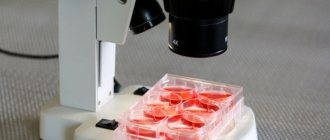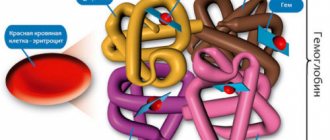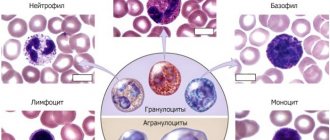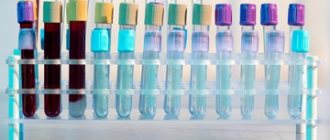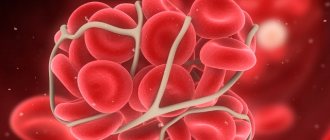What is the coagulation system
The hemostasis system is very complex, involving many tissue and serum factors. Its launch is really similar to a cascade: it is a chain of reactions, each subsequent link of which is accelerated by additional enzymes.
A simplified blood coagulation scheme looks like this: thromboplastin is released from the damaged endothelium, with the participation of calcium ions and vitamin K, it activates prothrombin. Prothrombin is converted to active thrombin, which in turn triggers the formation of insoluble fibrin from soluble fibrinogen. This process is completed by the stage of retraction of the blood clot, that is, its compaction and the actual blockage of the damage.
At each stage, many more factors are involved in this scheme. In total, there are 13 plasma and 22 platelet types.
What is prothrombin
This is a glycoprotein produced in liver cells, plasma coagulation factor II.
The synthesis of prothrombin requires vitamin K, so one of the reasons for its decrease is insufficient intake of this vitamin from food or a low level of its synthesis in the intestines.
Prothrombin is an inert protein, its activation occurs under the influence of coagulation factor XII (internal system) or when the endothelium is damaged (external mechanism of hemostasis).
The normal level of prothrombin in the blood is 0.1-0.15 g/l. However, its quantitative determination is not used in routine diagnostics. This is a rather unstable protein, easily destroyed and difficult to separate into a separate fraction and count.
In practice, qualitative tests for prothrombin are used, which reflect its content in the blood only indirectly. They are based on calculating the period of time during which the blood clots when thrombokinase activators are added to it (which in turn activates prothrombin, converting it into thrombin, and thrombin catalyzes the conversion of fibrinogen into fibrin).
Therefore, when we say “test for prothrombin”, “blood for prothrombin”, this does not mean determining its concentration in the blood, as, for example, glucose, hemoglobin or bilirubin are examined. And the result is given not in quantitative units, but as a percentage. This concept characterizes the external mechanism of hemocoagulation as a whole and reflects the activity of the entire prothrombin complex (factors II, V, VII, X).
Prothrombin time - what is it?
Depending on what caused the bleeding, blood can clot in several ways - internal or external. In the first case, this is due to the fact that the vessels are damaged from the outside. This can happen due to abrasions, bites or bruises. In the second case, the integrity of the walls of blood vessels from the inside occurs. This is caused by toxins, antibodies, and various pathogenic microorganisms.
Prothrombin time is an indicator by which you can understand how the internal pathway works in the hemocoagulation system.
Prothrombin time increases as a result of the following factors:
The body lacks vitamin K.
Kidney pathologies.
Taking certain medications.
The bile ducts are blocked or inflamed.
Absorption of fats in the intestines is impaired.
The more prothrombin in the blood is lowered, the higher the prothrombin time will be, because in this state the clotting process will be slowed down.
Prothrombin-lowering factors can be:
- A decrease in petit occurs in women who are carrying a baby.
- Syndrome – DIC.
- There is a deviation from the norm of hematocrit.
Prothrombin time may show a low result if the blood was taken incorrectly or the plasma was stored for a very long time before the study.
How are prothrombin tests performed?
The essence of almost all methods for studying the activity of the prothrombin complex is to calculate the time of formation of a fibrin clot immediately after adding activators to the blood, as well as comparing this time with normal values.
Blood is drawn into a test tube with an anticoagulant (sodium citrate). The test tube with citrated blood is slightly heated in a water bath. A reagent consisting of thromboplastin and calcium chloride is added to it. The time of loss of fibrin fibers is measured using a stopwatch. This is prothrombin time (PT). Its normal value is 11-15 seconds.
Having determined the patient's PT, it is compared with the normal prothrombin time (PT). It is usually indicated on the reagent bottle and depends on the activity of the thromboplastin used. Usually this figure is from 12 to 18 seconds (it may be different in each new reagent sample). The ratio of PVN to PT of the subject, expressed as a percentage, is the prothrombin index (PI). Its normal value is 80-105%. The longer the blood clotting time (PT), the lower the PI, which will indicate hypocoagulation.
Preparing for the study
Blood is taken before 11 o'clock in the morning. The most accurate results are observed when performing the analysis on an empty stomach. It is important to prepare for the study by following these recommendations:
- 2-3 days before the test, refuse fatty fried foods and strong alcoholic drinks, which additionally burden the liver;
- the patient must stop smoking three hours before the blood test, since nicotine can cause a sharp decrease in the prothrombin index;
- if continuous use of medications is necessary, their use should be discontinued six hours before the study;
- limit physical activity that causes fatigue;
- Blood sampling is not recommended for women during the menstrual period, when the blood in the body is renewed;
- During pregnancy, the study results will also have their own errors; the norm shifts by several points.
Blood taken from a vein is placed in a test tube with saline solution. Then the tube is placed in a centrifuge, waiting for the plasma to separate. The latter will be examined in more detail later.
When prothrombin according to Quick is elevated, what does this mean interests many.
Prothrombin according to Quick
The test is also based on the ratio of the patient's normal prothrombin time to the patient's PT, expressed as a percentage. But the method is considered more accurate. For the study, several dilutions of plasma are used (1:2, 1:3,1:4) and the construction of a calibration graph. For each dilution, the PT is determined and marked on the graph.
Prothrombin rates according to Quick are from 75% to 140%.
Within the normal protein content, the Kwik and PTI results may be identical. At low contents, these indicators sometimes diverge.
Another indicator is the INR (international normalized ratio). It is mainly used to assess the effectiveness of anticoagulants. This indicator is calculated using the formula:
INR = (patient's PT/normal PT)*value of the international thromboplastin sensitivity index (ISI).
This index is indicated on each package of the reagent. INR allows standardization of the results of PT and IPT performed in different laboratories. The INR value in healthy individuals is 0.8-1.2.
The numbers of prothrombin according to Quick and INR are inversely proportional to each other: if prothrombin according to Quick is increased, then the INR is reduced and vice versa.
Established standards for the prothrombin index
As already mentioned, the prothrombin index is calculated using two time indicators:
- coagulation of plasma taken from the patient;
- coagulation of control plasma.
This indicator is expressed as a percentage, therefore, the norm will also be a percentage.
There are two ways to determine the prothrombin index:
- Traditional - depends on the sensitivity of the reagents used in the analysis process.
- According to Quick, it is considered more accurate, since it is determined according to a calibration graph, which is constructed based on the results of measuring time periods, thanks to control plasma solutions of varying degrees of dilution.
Comparison table of standards:
| № | Prothrombin index | norm (%) |
| 1. | Traditional | 95-105 |
| 2. | By Kwik | 78-142 |
When is prothrombin tested?
A coagulation test (coagulogram) is not a routine examination; it is not prescribed to all patients in a row. The test is carried out in the following situations:
- The presence of symptoms indicating problems with clotting: frequent nosebleeds and other bleeding, bruising for no apparent reason, bleeding gums when brushing teeth, hemorrhagic rash on the skin.
- Thrombophlebitis of the veins of the lower extremities.
- Examination of the patient before any surgical interventions.
- Pregnant women must be examined.
- Control during treatment with anticoagulants. They are prescribed to patients with arrhythmias, after valve replacement, and for thrombophlebitis. The purpose of these drugs is to increase blood clotting time, but keep it within a safe range. In this case, PT will be increased by 1.5-2 times, PTI and prothrombin according to Quick will be reduced, INR will be increased (safely up to 2-3).
- For liver diseases to clarify its functional insufficiency.
- Before prescribing estrogen-containing hormones, as well as during their use.
How to normalize prothrombin levels
To correct a slight decrease in the activity of prothrombin production, the treating specialist may prescribe a diet with an increased amount of foods containing natural vitamin K (see the list in the “Preparation for Screening” section). It is recommended to normalize water balance by optimizing fluid consumption to 2 liters of clean water per day. In order to prevent possible bleeding, it will be recommended to avoid using medicinal decoctions based on tansy, yarrow and nettle.
To slightly reduce the production of prothrombin, a diet with a predominant content of tomatoes, tomato juice, large amounts of onions and garlic, flaxseed, oatmeal and olive oil is suitable. Fish and seafood seasoned with apple cider vinegar are also recommended. From fruits: lemons, raspberries, strawberries, cranberries and cherries.
Needs clarification. It is possible to normalize significant deviations of prothrombin values from the norm only by identifying and, if possible, eliminating the true basis of such a clinical symptom.
Prothrombin norms in different groups of patients
The levels of this glycoprotein in the blood vary somewhat among different age groups. In children under 18 years of age, its normal content ranges from 80 to 110%, in adults – from 78 to 145%.
The norms for adult men and women are no different. A moderate increase in prothrombin may occur in women before childbirth.
Prothrombin index
This indicator is determined in all coagulograms. What does prothrombin index mean?
The normal prothrombin index is 80-105%. The greater the patient’s PV compared to normal, the lower his PI will be and vice versa. Accordingly, a low index indicates poor coagulability, and a high index indicates hypercoagulation (propensity for thrombosis).
The prothrombin index test is prescribed in the same situations as the Quick prothrombin test. Basically, both of these values are in direct correlation and in the range of normal content can be the same.
The norm of the prothrombin index during pregnancy differs slightly by trimester:
- I trimester – 80-119%
- II – 85-120%
- III – 90-130%.
Prothrombin is increased
An increased level of prothrombin in the blood indicates that blood clotting is greater than normal. This means that it becomes too viscous, which impedes blood circulation and leads to blockage of blood vessels.
The following ailments can provoke an increase in prothrombin levels, and therefore blood clotting:
- malignant neoplasms;
- liver pathologies;
- thromboembolism;
- polycythemia;
- progressive angina.
An increase in the amount of protein can also be caused by the following factors:
- an excess of vitamin K in the body, with the help of which prothrombin is produced;
- use of anticoagulants, antibiotics, nicotinic acid, and hormonal contraceptives in therapy. Excessive use of aspirin, anabolic steroids, and laxatives can also affect the increase in prothrombin.
Quite often, the protein content increases during pregnancy. Most often it appears in the last trimester and does not require treatment.
How to decipher a coagulogram
This analysis is carried out in order to obtain answers to the questions:
- does the blood clot normally?
- is there a risk of postoperative or postpartum hemorrhage;
- what is the cause of frequent bleeding and bruising;
- what dose of anticoagulants is safe if their use is necessary.
Blood hypocoagulation and tendency to bleeding will be indicated by:
- reduced prothrombin according to Quick (less than 75);
- decreased prothrombin index (less than 80);
- increased prothrombin time (more than 18 seconds);
- increased INR (more than 1.3).
Hypercoagulability and tendency to form blood clots is characterized by:
- increased prothrombin index (more than 110);
- increased prothrombin (above 145);
- shortening of PT (less than 10 s);
- decrease in INR value less than 0.8.
Decoding the analysis results
Increased prothrombin levels - risk of bleeding
An increased level indicates an increase in clotting time and provokes a tendency to bleeding. If a vessel is damaged, the hemostasis system is not able to create an obstruction in a timely manner, which can lead to bleeding. The inability of blood to clot naturally in severe forms is manifested by a tendency to internal bleeding, as well as spontaneous hemorrhages.
The well-known disease hemophilia, which is characterized by a congenital deficiency of one of the coagulation factors, in past centuries was the cause of death due to the inability to prevent bleeding. Today, there are many methods and means for correcting elevated PV levels, the main thing is to stop the development of pathologies that provoke an increase in blood clotting time in a timely manner.
A reduced level means that the blood’s tendency to form blood clots, that is, thrombophilia, increases. This condition can lead to thrombosis of veins, arteries and capillaries, which can lead to the development of pathologies of internal organs. Blood clots blocking blood vessels prevent the circulatory system from delivering oxygen throughout the body and releasing carbon dioxide from tissues. The formation of clots in the portal vein provokes liver failure, in the arteries of the brain - a stroke, and so on.
Thrombophilia is a common disease; in various countries, the number of people suffering from this phenomenon ranges from 15 to 40%. Modern medicine has the means to combat the disease, but it must be identified as early as possible. Therefore, it is so important to monitor the state of hemostasis of your circulatory system.
The main reasons for the decrease in prothrombin
We remember that prothrombin is a protein that is formed in liver cells with the participation of vitamin K. It becomes active with the help of several tissue and plasma clotting factors. The gene responsible for normal prothrombin synthesis is recessive and is located on chromosome 11.
In addition, there are also anticoagulant factors in the blood, the increased activity of which can inhibit the components of the prothrombin complex.
The main causes of low prothrombin and IPT (PT and INR are increased) follow from this physiological mechanism:
- Congenital pathology - changes in the genes responsible for the synthesis of prothrombin (quite rare).
- Liver diseases accompanied by decreased function or death of hepatocytes: chronic hepatitis, cirrhosis. The insufficiency of structural units for synthesis leads to the fact that prothrombin in the blood is reduced.
- Vitamin K deficiency. This happens both when there is insufficient intake from food, and when its absorption and synthesis in the intestines is impaired. Therefore, gastrointestinal diseases accompanied by dysbiosis and impaired fat absorption can also lead to its deficiency.
- Reduced levels of blood clotting factors V, VIII, X.
- Autoimmune diseases, including the production of antibodies to prothrombin (more precisely, to the phosphatidylserine-prothrombin complex).
- Low fibrinogen levels.
- 2nd phase of DIC syndrome (exhaustion phase).
- Increased activity of the anticoagulant factor antithrombin III.
- Treatment with anticoagulants (heparin, fraxiparin, warfarin, neodicoumarin).
Reasons for PTI deviations
There are several groups of reasons why PTI may be lowered or increased. The most common reason for the decrease is liver pathology. If this organ suffers from a particular disease, then it can no longer synthesize the necessary substances in the required quantities, many biochemical reactions are disrupted, prothrombin becomes less, and the prothrombin index is lower (INR is higher). These changes characterize diseases such as acute and chronic hepatitis, fatty degeneration, cirrhosis and some others. This is a warning sign during pregnancy, indicating possible complications from the liver and kidneys.
Another important reason is vitamin K deficiency. It can occur when the body’s need is increased, for example, during pregnancy. In addition, its absorption in the intestine may be impaired due to dysbacteriosis or bile deficiency. A hereditary deficiency of prothrombin complex factors cannot be ruled out. In addition, PTI can be reduced while taking certain medications:
- steroids;
- antibiotics;
- aspirin in large doses;
- some laxatives and diuretics;
- nicotinic acid, methotrexate, etc.
Also, the prothrombin index becomes lower in DIC syndrome caused by chronic pancreatitis, pancreatic cancer, leukemia and other causes. The consumption of coagulation factors in DIC syndrome is increased, and ultimately their depletion is observed, which leads to a decrease in PTI.
If the index is above 110%, then there is a high risk of spontaneous abortion. In addition, PTI is increased in polycythemia and in the initial stages of deep vein thrombosis of the legs, as well as under the influence of low doses of aspirin, mercaptopurine and oral contraceptives in women. If the prothrombin index in the coagulogram is higher than normal, this indicates a danger of thrombosis.
A blood coagulogram test is a very informative study. When deciphered, each indicator has great diagnostic value. Thus, there are a huge number of reasons why PTI in women may be higher or lower than normal, and finding out them is a very important task. To solve it, a biochemical blood test and a number of additional studies may be required that will complement the coagulogram data. Based on them, conclusions will be drawn about the presence of a particular disease, the development of pathology in women during pregnancy, etc. And this, in turn, will help prescribe the correct treatment, as a result of which the prothrombin index, becoming higher or lower, will return to normal values.
Reasons for increased prothrombin and PTI
An increase in PTI indicates hypercoagulation and is dangerous for the development of thrombosis (heart attacks, strokes, thrombosis of the veins in the legs, pulmonary embolism). This condition is especially unfavorable after operations and after childbirth.
- Last weeks of pregnancy.
- DIC – syndrome (1st stage).
- The use of estrogen-containing hormones by women (and sometimes men).
- Congenital thrombophilia.
- Excess vitamin K.
- Mutation of the prothrombin gene G20210A (carriers of the defective gene are 2-3% of the population).
- The period after severe operations, burn disease.
- Postpartum stage.
- Malignant tumors.
- Antithrombin III deficiency.
- Antiphospholipid syndrome.
Rules for taking the analysis
Before submitting blood to the laboratory, certain preparatory steps must be taken. These include:
- The test is taken on an empty stomach. The ideal time to visit the laboratory is the first morning hours, which is no later than eleven in the morning. Food is consumed in advance, but its last intake should be taken no earlier than 14 hours before the intended blood draw from a vein.
- On the eve of the expected test, you need to avoid fried and smoked foods, as well as drinking alcoholic beverages. Smoking should be limited one hour before visiting the clinic, as non-compliance with recommendations will affect the analysis.
- The medications taken during the course must be discontinued . Sometimes this is not possible and the patient must continue taking medications, then you need to write the exact dosage and the name of the drug for the doctor.
The process of donating blood itself consists of taking it from a vein into a test tube with a special substance. Through a centrifuge, the resulting plasma is separated from the blood cells.
Article on the topic:
The hormone prolactin. Normal in the female body depending on age
Causes of reduced prothrombin
If the prothrombin index is low, then even the slightest damage can provoke bleeding that is difficult to stop. Thrombus formation occurs more slowly than normal.
Low prothrombin levels indicate the following reasons:
- Taking medications that lead to high clotting.
- Insufficient amount of vitamin K, which promotes protein secretion.
- Liver damage and ailments . The content of prothrombin decreases in chronic and acute forms of hepatitis. Cirrhosis can cause a low index.
- A small amount of fibrinogen , which is produced by the liver and then becomes fibrin.
It is possible to increase the level of prothrombin, but only after a comprehensive examination and with a prescription from the attending physician. Only he knows how to increase prothrombin levels. Since self-treatment is prohibited.
Therapy formulated by a medical specialist will be aimed at eliminating the problem. Often the therapeutic complex includes not only drug treatment, but also a special diet.
Cause of increased prothrombin
If it turns out that prothrombin is increased, then we can conclude that the blood is too viscous, which means its coagulability is greater than normal. This can lead to blockage of blood vessels.
The following reasons can provoke increased values:
- thromboembolism;
- oncology;
- liver diseases;
- angina pectoris;
- polycythemia.
An increase in prothrombin can be caused by an excess of vitamin K, from which this protein is released. Often the appearance of excess protein appears in the third trimester of pregnancy and requires treatment. The doctor will prescribe medications to lower the levels.
What to do with indicators that do not fit into the norm?
Prothrombin is increased or decreased, what to do?
First, you need to see a doctor. Many people think that the answers to all questions can now be found on the Internet. In fact, this is far from the case. This is especially true for the coagulation system. The information presented on the Internet about this matter is very confusing and 50% of it is completely wrong. This indicates the high complexity of this issue.
Which doctor should I contact?
To the one who ordered the analysis. If you took a coagulogram on your own, first we go to a therapist.
What should you definitely tell your doctor?
- You must list all medications that you are taking or have taken recently, including dietary supplements. Many medications tend to affect coagulogram parameters, and this applies not only to anticoagulants. Thus, Nevigramon, Streptomycin, Tetracycline, Levomycetin, L-thyroxine, vitamin A, and Aspirin in high doses can reduce prothrombin.
The following can increase PTI: contraceptive hormonal drugs, caffeine, antihistamines, high doses of vitamins C, K, corticosteroid hormones.
- Long-term alcohol abuse can also reduce PTI.
- An excess of foods rich in vitamin K in the diet can lead to an increase in prothrombin, and insufficient consumption of them can, on the contrary, lead to a decrease. These are foods such as greens, green vegetables and fruits, liver.
- Women must be informed about their pregnancy.
What additional examinations can be prescribed?
- Liver function test (advanced biochemical analysis with determination of bilirubin, liver transaminases, total protein, albumin).
- Ultrasound of the liver and biliary tract.
- Fibroelastography of the liver for suspected cirrhosis.
- Determination of antibodies to viral hepatitis.
- Extended examination of the coagulation system (APTT, fibrinogen, thrombin time, D-dimers, plasminogen, antithrombin III, plasma fibrinolytic activity, lupus anticoagulant, etc.)
- Intestinal examination (stool analysis for dysbacteriosis, colonoscopy).
How to lower or increase the prothrombin index?
If the readings are only slightly outside the normal range, there is no need to panic. It is possible that some time after stopping some medications, a repeat analysis will not reveal any abnormalities. Many women are concerned about the question - what to do with taking contraceptives? If cardiovascular diseases are diagnosed, definitely stop taking it, but if the woman is generally healthy, the pills can be taken, but the analysis should be periodically monitored.
You can also try to correct PTI with a diet if you are sure that your diet is clearly lacking foods such as greens (parsley, dill, spinach), vegetables (cabbage, broccoli), beef or pork liver. Green tea improves PTI quite well.
If prothrombin levels are elevated and there is a risk of thrombosis, doctors usually prescribe anticoagulants. At the same time, only warfarin will clearly reduce this indicator. New generation anticoagulants (Pradaxa, Xarelto, Eliquis and others) act on other coagulation factors, but the level of prothrombin may not change.
Aspirin also does not change this indicator, but taking it in small doses makes sense to reduce the risk of blood clots.
In what cases should you not waste time on a diet?
- If the coagulogram values are significantly higher or lower than normal.
- There are symptoms of impaired homeostasis: recurrent bleeding or thrombosis.
- Presence of pregnancy.
- Abnormal coagulogram in a child.
- There are other symptoms (yellow skin, dark urine, swelling, rash, itchy skin, etc.)
In these cases, you need to undergo a full examination and find out the cause of the pathology of the coagulation system.
Author:
Akimova Valentina Konstantinova general practitioner
Analysis for PTI during pregnancy
All women must undergo such examination during pregnancy. Due to hormonal changes and the appearance of placental-uterine circulation in pregnant women, this figure is slightly increased and amounts to 90-120%, which is considered normal.
During the entire period of gestation, women are prescribed tests 2-4 times.
This is especially important shortly before childbirth, in the last trimester. When PTI decreases to 80%, there is a high risk of bleeding during or after childbirth
If the indicator is increased to 160%, placental abruption is possible. In these cases, the expectant mother is placed in a hospital, where she is monitored until birth. In this way, doctors have the opportunity to better prepare for childbirth and avoid complications, including deaths.
